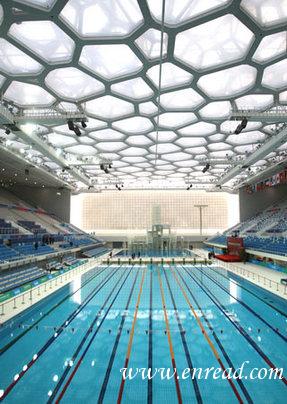Until Sunday, the Olympic "Water Cube" in Beijing was best known for being blue and bubbly and bright at night. Now the Olympic swimming pool inside may get more attention.
A dozen world and Olympic records fell at the pool Sunday, most in preliminary heats. American Michael Phelps started the record run with a new world mark in the 400-meter individual medley event. That won him his first gold medal of the 2008 games.
Ten hours later, the US men's 4-by-100 freestyle relay team also set a world record.
Records often fall at the Olympics, because athletes spend four years preparing and their performances often peak at the games. But the pool itself may deserve some credit.
"It's by far the fastest pool in the world," says Rowdy Gaines, an Olympic medalist and swimming commentator for Olympic broadcaster NBC. "If you step into this arena, you'll see a thing of beauty. ... It's really a thing of absolute beauty."
Gaines is not referring to the futuristic exterior. He focuses on the design of the pool, which discourages turbulence and encourages speed.
"I'm talking about deep water," Gaines explains. "It's a perfect depth because if it's too deep, you lose your sense of vision and where you're at in the pool. But it's just deep enough to where the waves dissipate (and) the turbulence dissipates down to the bottom."
The Water Cube pool also has 10 lanes instead of eight. Waves churned up during races don't bounce back into the swimming lanes. Waves that reach the sides are siphoned off by perforated gutters.
"It's physics and it's not sports, but it makes sense," says Christine Brennan, a veteran of 13 Olympics and an Olympics columnist for USA Today. "You make a deeper and a wider pool, and you ... give all of those waves and all of that splashing and all of that moving water a chance to move away from the swimmers and get out of their way, which makes them go faster. It's as simple as that."
The Water Cube pool is close to 10 feet deep. That's 3 feet deeper than the pools of the past. The lane lines that separate swimmers are called wave eaters because they dissipate turbulent water. The goal is to make the water as flat and clear as possible, despite the churning that swimmers create.
An indoor setting also helps, along with temperature, humidity and lighting control. Wide decks with seats sharply cascading back give swimmers an uncrowded sense of space. That can energize athletes, like American Dara Torres, who calls the pool "awesome."
"Everything is just fantastic about this pool. I've never seen such a big facility in my life. And you get a great feeling walking into that facility, knowing that this is where the Olympic Games are (held)."
The technology used in the Water Cube pool is standard now for competitive pools. Gaines believes the pools have reached their technological limits.
"Technology has really kind of tapped out as far as the building of these kinds of facilities," Gaines says. "I can't imagine them getting better."
All that's left, Gaines suggests, is making the water faster, perhaps by changing its chemical composition. Competitive pools, for example, once contained salt water, which increased buoyancy and speed. But Gaines doubts whether water can actually be altered in a way that would help swimmers swim faster.
"It's not like track and field, where the types of tracks ... just get faster and faster because, I guess, there is more spring to them," Gaines says. "But I don't know how you make fast water. It's just not possible."
In fact, new technology lately has focused on high-tech swimming suits that decrease resistance. Those suits and a fast pool and the intensely competitive atmosphere of the Olympics mean more records are likely to fall in Beijing.

没有评论:
发表评论